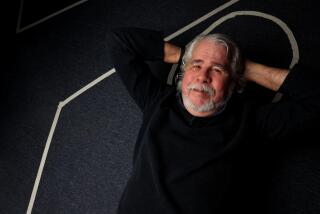The Straw Man From the Black Lagoon : No One Wants Musty Versions of the Classics
In horror movies, the monster traditionally goes up in flames in the finale, only to lurch from the swamp in the sequel.
With equal persistence, a straw man called “Museum Theatre” keeps dragging itself from beyond the grave whenever the subject of staging the classics comes up.
Here is Bill Bushnell of the Los Angeles Theatre Center in last week’s Letters Annex:
“Sullivan is determined to convince his readers, and those of us who practice the art of the theater, that the classics should be interpreted ‘straight.’
“Well, he is totally out of step with the modern theater. Today every director of quality attacks the classics in a highly individualistic and totally contemporary way. Their objective is to create a production that speaks to our time, not one that reproduces a museum version of the original.”
Bushnell had written Calendar to defend Norwegian director Stein Winge’s productions for LATC, starting with his “startling, postmodern” view of “Three Sisters”--the one where everybody kept falling down.
But it’s a new year, and the purpose of this column isn’t to take another swipe at Winge. It is to restate what has been actually said in this space about classical productions, as opposed to what Bushnell thinks he has read.
In brief:
1--Nobody wants museum theater.
2--Everybody wants productions that “speak to our time.”
3--These can be achieved by playing the text straight or any other way the director wants to try.
4--No approach guarantees success.
Point by point:
1--The place for museum theater is museums. I once wrote a column recommending that the Getty underwrite the staging of old plays under their original performance conditions, to see whether this would shed light on the text. Would “The Taming of the Shrew” seem more brutal or more good-natured if performed by an all-male company in broad daylight?
That’s not the same as demanding that “Taming of the Shrew” always or even usually be played that way. Anyone who thinks that classical productions should be “museum versions of the original” should recall the D’Oyly Carte Opera Company, which died of excessive fidelity to the original prompt-books of W.S. Gilbert.
One rainy afternoon in London, I saw a D’Oyly Carte “Trial by Jury” where the younger members of the troupe didn’t have a clue as to why the geometric stage business that they were laboring through had once been considered funny. They were like recruits doing close-order drill. You knew the company couldn’t last.
A few years later in Israel, I watched a performance by a light opera company that was still doing the old Lehar favorites exactly as they had done them in Europe before World War II. Even the old people in the audience knew that something was wrong. When theater gets stuck in a time warp, it dies. Nobody wants that to happen to the classics.
2--Obviously, the classics have to speak to today’s audience. What other audience is there? Not only that, they have to say something in particular. Not necessarily something directed to an issue of the day, as with Orson Welles’ anti-fascist “Julius Caesar” in the mid-’30s. But something more than: “Admire me. I am a classic.”
An example of that approach was the BBC’s “Shakespeare Plays” series, which set out to present the Shakespeare canon without directorial distortion, and ended up with a series of prim pageants where everyone wore period costumes and spoke up nicely.
Compare that approach with the Royal Shakespeare Company’s TV “Macbeth,” where Trevor Nunn’s players drifted in and out of a foggy circle, like a coven doing hateful things on the moor. Which approach did more to interest young viewers in Shakespeare?
3--We want directors to have strong ideas about the classics. We want them to go into a production feeling that they alone have rooted out the play’s secret--sometimes its dirty little secret--and that today’s audience is absolutely ripe to hear it.
This may involve changing the look of the play. Bushnell once staged “Macbeth” as if it were happening in a burned-out shopping mall after a nuclear war. This week the Acting Company brings its “Kabuki Macbeth” to the Doolittle Theatre. Orson Welles and John Houseman did a “Voodoo Macbeth” for the Federal Theatre. A director who can’t stand the Macbeths might take a hint from Mary McCarthy’s essay and put them in the suburbs.
Some directors even take it upon themsleves to change the text. This is not a cause for panic. The great plays can take any amount of cutting, pasting, updating, warping and even defacing. If what comes out isn’t the play, but is an interesting attack on the play or the myth behind the play, that’s OK, too. (As long as the audience knows what it’s being sold, as with Richard Schechner’s “Makbeth,” purposely spelled with a k .)
The Mona Lisa wouldn’t survive many attempts at painting a mustache on it, but “Macbeth,” the text, is as unkillable as our straw man. So fire away, ye conceptualizers.
4--But no approach guarantees success, including the traditional. San Francisco’s ACT did “Uncle Vanya” at the Doolittle Theatre shortly before Winge’s “Three Sisters” at LATC. The ACT production was as “Chekhovian” as could be. Everybody in it was either sadly beautiful, sadly comical or sadly brave. The actors were so busy being poignant that they forgot to be alive.
You could see why Winge wanted to kick a hole in that approach. But his approach turned out to be equally reductive: a question of turning the Prozorovs into hysterics who kept tripping over their feet. You could see the attempt to be original and startling, but the play wasn’t opened up--it was narrowed. The real subject of the production was the director’s mind-set towards his material.
That’s allowable, too, if the director has an interesting mind. But there are two minds on display when a classic gets done--that of the author and that of the director. When they get into competition, the audience has to choose one or the other.
The playwright usually has a pretty good mind, or the play wouldn’t have held interest for so long. But if all the director can do is to devalue the characters, he ends up looking a little obtuse, like the D’Oyly Carte juveniles who didn’t understand the system of the work they were performing.
Another example: In doing Shakespeare (whether doing him straight or standing him on his head), the director can’t let the issue of language slide. Bushnell’s “Macbeth” failed because his actors couldn’t handle the words, something that an interesting concept can’t long disguise.
This is as much a problem with Joseph Papp’s Shakespeare productions as with Bushnell. It’s because director Simon Callow handled the language issue so well in LATC’s “Jacques and His Master” last year--not by imposing a trans-Atlantic accent on his multiracial cast, but by getting them to address the text with alacrity and precision--that we look forward to his future work with the theater.
In the end, the crucial question isn’t whether a director is doing a text straight or trying to subvert it. It’s how well the director knew the text to begin with: its structure, its music, its psychology, the mind that produced it, the politics that produced it. The clearer the director is about these issues, the likelier he is to be able to put the play into terms that will make sense in our time.
Here the director, or his literary manager, does need some of the scholarship to be found in a good museum staff. And also some of its respect for the past, which is not to be confused with a desire to retreat to it--simply a recognition that some rather interesting work got done back then.
But this is not the same as asking for “museum theater.” Let LATC’s classical work be “totally contemporary,” to the max.
As long as it plays.
Die, monster.
More to Read
The biggest entertainment stories
Get our big stories about Hollywood, film, television, music, arts, culture and more right in your inbox as soon as they publish.
You may occasionally receive promotional content from the Los Angeles Times.










